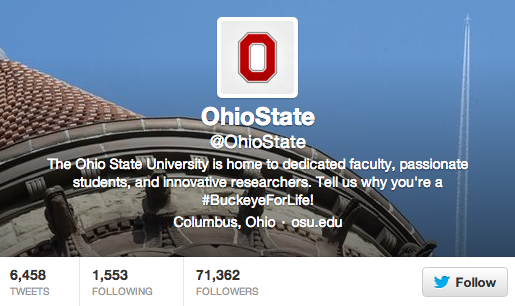
OSU was recently ranked No. 9 on the list of Top 100 Social Media Colleges, compiled by Student Advisor.
Credit: Screenshot of OSU’s Twitter account, @OhioState
Ohio State was recently ranked among the Ivies, at least in terms of its social media usage.
OSU was ranked No. 9 in the nation for colleges using social media. The list, called the Top 100 Social Media Colleges, was compiled by Student Advisor, a Washington Post company.
Other colleges that topped the list included Ivy League schools, such as Harvard University (No. 1) and Yale University (No. 4), as well as other schools like Stanford University (No. 2) and University of Oregon (No. 8).
Student Advisor is a website that aims to help students find the right college, said Dean Tsouvalas, the editor-in-chief of the site. The Top 100 Social Media Colleges is an annual list that has tracked colleges’ social media efforts for more than three years.
“We recreate a list that is scientifically calculated. We track every school’s Twitter accounts, Facebook accounts, YouTube channels, Google+ and LinkedIn and put it in a formula,” Tsouvalas said.
On these different platforms, the formula takes into consideration the enrollment of the school, how many people are following the social media page and the level of engagement between the college and the individuals who communicate with them, Tsouvalas said.
OSU’s Facebook page had about 534,000 likes as of Tuesday, while its Twitter account, @OhioState, had more than 71,000 followers.
“It’s very gratifying to see Ohio State recognized as a social media leader in higher (education),” said Kristen Convery, the director of OSU multimedia content, in an email. “Rankings like this reflect the hard work of a great team in university communications.”
Ted Hattemer, the assistant vice president of OSU interactive communications, said his team is currently working on managing the different social media platforms to engage more followers by participating in a “real management tool.”
“We’ve been using it since the beginning of summer (to) really track how many conversations are in place,” Hattemer said.
By tracking the different platforms and engaging with the audience, OSU communications has been trying to have more conversations with followers, Hattemer said.
“We’ve focused in on moving from the publishing to the next phase of having that conversation,” Hattemer said. “Hopefully that’s what people have been noticing. That’s what we’ve really been focusing on and hopefully that has reflected. Maybe our ranking on this list is a reflection of that.”
Karen Riggs, a professor in Ohio University’s School of Media Arts and Studies, said what OSU is doing is “amazing,” but she doesn’t think just being in the top 10 means much.
“What is important is the institution themselves being successful … if you aren’t using social media competently, (the college) is failing,” Riggs said.
Social media is an ideal outlet to reach potential students, Riggs said.
“You find these colleges and they have buttons on the front page of their website to all of their social media,” Riggs said. “It’s important to be able to be savvy to a potential recruit.”
Tsouvalas agreed that social media is an important way to reach high school students.
“If you are not talking on social media and connecting with students, basically you don’t exist,” Tsouvalas said. “Social media has radically changed admission for students, for parents, for faculty in ways that are extraordinary.”
A student poll published by Art & Science Group, LLC, in September 2013, found that 44 percent of students reported they had gathered information about potential colleges from social media sites. That percentage had grown since 2008 when less than one-fifth of students reported they had used social media sites to form an impression about a college.
Some OSU students said they used social media in making their college decision.
Ali Casiere, a fourth-year in health information management and systems, said there have been changes in social media since she initially came to college.
“I feel so old saying this, but it’s a lot different now (from when I first came to college),” Casiere said. “You ‘like’ more things, it wasn’t as much of a thing (then) like it is now.”
It’s important to change with the times and trends of social media, Riggs said.
“It’s not, ‘Oh, we need a Twitter,'” Riggs said. “(It’s) ‘How do you use Twitter to adjust?’ How you used Twitter a year ago is not how you use it now.”
Casiere said she predominantly uses Twitter to keep up to date on OSU news.
“Twitter accounts are the most informative,” Casiere said. “You hear about break-ins on Twitter before (University Police officers) even send out the (crime) notices.”
Riggs said it’s not enough to have a presence on just one social media platform, though.
“Using Twitter and Instagram are platforms that are essential,” Riggs said. “Having YouTube channels are essential, but not just having one, but what you put on it to engage users.”
OSU has been using fan pages since 2008-09, Hattemer said, and has just recently started Instagram and LinkedIn platforms in addition to its Facebook, Twitter and YouTube accounts.
Kat Dickey, a fourth-year in accounting, said she wasn’t surprised, but was impressed that OSU made the top 10.
“It’s a focus on reaching out to students,” Dickey said. “It’s smart business-wise and a great marketing technique.”
Hattemer said he understands how vital social media is to the OSU brand.
“It’s tremendously important. All you have to do is look at the traffic it drives to our websites,” Hattemer said. “That’s ultimately the goal of the digital space – to engage with the audiences and make sure that any services that we are offering are promoted by them … Social media is one of the main vehicles for driving traffic to those opportunities.”


